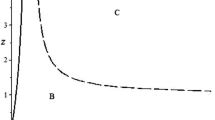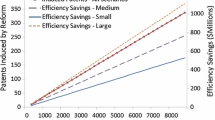Abstract
This paper examines whether the welfare gains from technological innovation that reduces future abatement costs are larger or smaller than the “Pigouvian” welfare gains from optimal pollution control. The relative welfare gains from innovation depend on three key factors—the initially optimal level of abatement, the speed at which innovation reduces future abatement costs, and the discount rate. We calculate the welfare gains from innovation under a variety of different scenarios. Mostly they are less than the Pigouvian welfare gains. To be greater, innovation must reduce abatement costs substantially and quickly and the initially optimal abatement level must be fairly modest.
Similar content being viewed by others
References
Burtraw, D., A. J. Krupnick, E. Mansur, D. Austin, and D. Farrell. 1998. “The Costs and Benefits of Reducing Air Pollutants Related to Acid Rain.” Contemporary Economic Policy 16: 379-400.
Carlson, C., D. Burtraw, M. Cropper, and K. Palmer. 2000. “SO2 Control by Electric Utilities: What are the Gains from Trade?” Journal of Political Economy 108: 1292-1326.
Carraro, C., and J. C. Hourcade. 1998. “Climate modeling and Policy Strategies. The Role of Technical Change and Uncertainty.” Energy Economics 20: 463-471.
Cropper, M. L., and W. E. Oates. 1990. “Environmental Economics: A Survey.” Journal of Economic Literature XXX: 675-740.
Dowlatabadi, H. 1998. “Sensitivity of Climate Change Mitigation Estimates to Assumptions about Technical Change.” Energy Economics 20: 473-493.
Downing, P. G., and L. J. White. 1986. “Innovation in Pollution Control.” Journal of Environmental Economics and Management 13: 18-29.
Fischer, C., I. W. H. Parry, and W. A. Pizer. 2002. “Instrument Choice for Environmental Protection when Technological Innovation is Endogenous.” Journal of Environmental Economics and Management, forthcoming.
EIA. 1999. Annual Energy Outlook 2000 (December). U.S. Department of Energy, Washington, DC: Energy Information Administration.
Goulder, L. H., and K. Mathai. 2000. “Optimal CO2 Abatement in the Presence of Induced Technological Change.” Journal of Environmental Economics and Management 3: 1-38.
Goulder, L. H., and S. Schneider. 1999. “Induced Technological Change, Crowding Out, and the Attractiveness of CO2 Emissions Abatement.” Resource and Energy Economics 21: 211-253.
Hammitt, J. K. 1997. “Stratospheric-Ozone Depletion.” In Richard D. Morgenstern (Ed.), Economic Analyses at EPA: Assessing Regulatory Impact. Washington, DC: Resources for the Future.
Jaffe, A. B., R. G. Newell, and R. N. Stavins. 2000. “Technological Change and the Environment.” Forthcoming in Karl-Göran Mäler and Jeffrey Vincent (Eds.), Handbook of Environmental Economics. Amsterdam: North-Holland/Elsevier Science.
Jaffe, A. B., and R. N. Stavins. 1995. “Dynamic Incentives of Environmental Regulations: The Effects of Alternative Policy Instruments on Technology Diffusion.” Journal of Environmental Economics and Management 29: S43-63.
Jung, C., K. Krutilla, and R. Boyd. 1996. “Incentives for Advanced Pollution Abatement Technology at the Industry Level: An Evaluation of Policy Alternatives.” Journal of Environmental Economics and Management 30: 95-111.
Kemp, R. 1997. Environmental Policy and Technological Change: A Comparison of the Technological Impact of Policy Instruments. Northampton, MA: Edward Elgar.
Keohane, N. O. 1999. “Policy Instruments and the Diffusion of Pollution Abatement Technology.” Discussion paper, Boston, MA: Harvard University.
Kneese, A. V., and C. L. Schultz. 1978. Pollution, Prices and Public Policy. Washington, DC: Brookings Institute.
Kolstad, C. D. 1996. “Learning and Stock Effects in Environmental Regulation: The Case of Greenhouse Gas Emissions.” Journal of Environmental Economics and Management 31: 1-18.
Milliman, S. R., and R. Prince. 1989. “Firm Incentives to Promote Technological Change in Pollution Control.” Journal of Environmental Economics and Management 17: 247-265.
Morgenstern, R. D. (Ed.) 1997. Economic Analyses at EPA: Assessing Regulatory Impact. Washington, DC: Resources for the Future.
Muradian, R. 2001. “Ecological Thresholds: A Survey.” Ecological Economics 38: 7-24.
Newell, R. G., and W. A. Pizer. 2000. “Discounting the Distant Future: How Much do Uncertain Rates Increase Valuations?” Discussion paper 00-45. Washington, DC: Resources for the Future.
Nichols, A. L. 1997. “Lead in Gasoline.” In Richard D. Morgenstern (Ed.), Economic Analyses at EPA: Assessing Regulatory Impact. Washington, DC: Resources for the Future.
Nordhaus, W. D. 1998. “Modeling Induced Innovation in Climate-Change Policy.” Discussion paper, New Haven, CT: Yale University.
Nordhaus, W. D. 1994. Managing the Global Commons. The Economics of Climate Change. Cambridge, MA: MIT Press.
Orr, L. 1976. “Incentive for Innovation as the Basis for Effluent Charge Strategy.” American Economic Review 66: 441-447.
Palmer, K., W. E. Oates, and P. R. Portney. 1995. “Tightening Environmental Standards: The Benefit-Cost or the No-Cost Paradigm?” Journal of Economic Perspectives 9: 119-132.
Parry, I. W. H. 1998. “Pollution Regulation and the Efficiency Gains from Technological Innovation.” Journal of Regulatory Economics 14: 229-254.
Parry, I. W. H. 1995. “Optimal Pollution Taxes and Endogenous Technological Progress.” Resource and Energy Economics 17: 69-85.
Peck, S. C., and T. J. Teisberg. 1994. “Optimal Carbon Emissions Trajectories when Damages depend on the rate or level of Global Warming.” Climatic Change 28: 289-314.
Petrakis, E., E. Sartzetakis, and A. Xepapedeas. 1999. Environmental Regulation and Market Power. Northampton, MA: Edward Elgar.
Porter, M. E., and C. van der Linde. 1995. “Toward a New Conception of the Environment-Competitiveness Relationship.” Journal of Economic Perspectives 9: 97-118.
Portney, P. R., and R. N. Stavins. 2000. Public Policies for Environmental Protection. (Second edition). Washingon, DC: Resources for the Future.
Portney, P., and J. P. Weyant. 1999. Discounting and Intergenerational Equity. Washington, DC: Resources for the Future.
Wigley, T. M. L., R. Richels, and J. Edmonds. 1996. “Economic and Environmental Choices in the Stabilization of Atmospheric CO2 Concentrations.” Nature 18: 240-243.
Author information
Authors and Affiliations
Rights and permissions
About this article
Cite this article
Parry, I.W.H., Pizer, W.A. & Fischer, C. How Large are the Welfare Gains from Technological Innovation Induced by Environmental Policies?. Journal of Regulatory Economics 23, 237–255 (2003). https://doi.org/10.1023/A:1023321309988
Issue Date:
DOI: https://doi.org/10.1023/A:1023321309988




